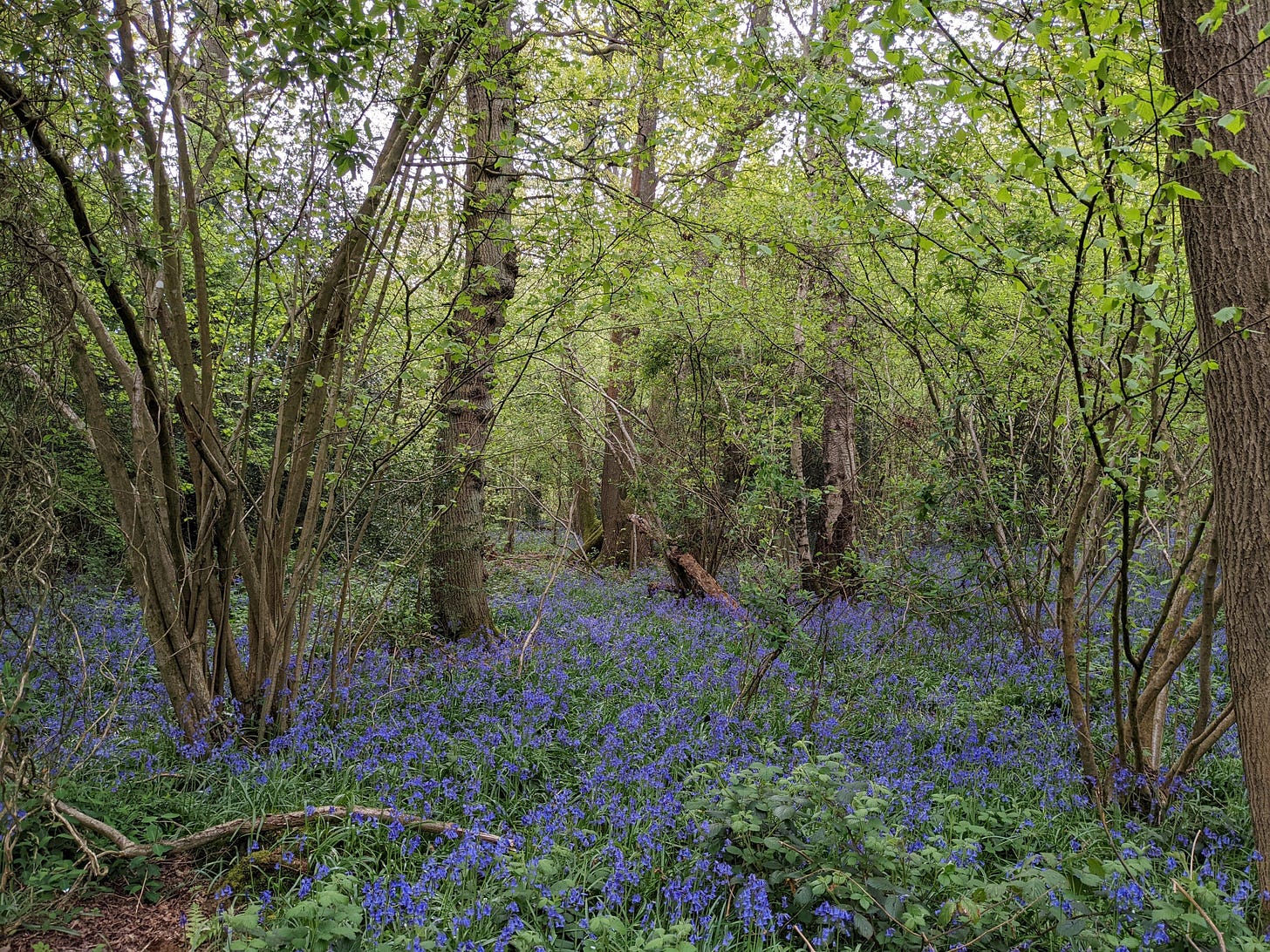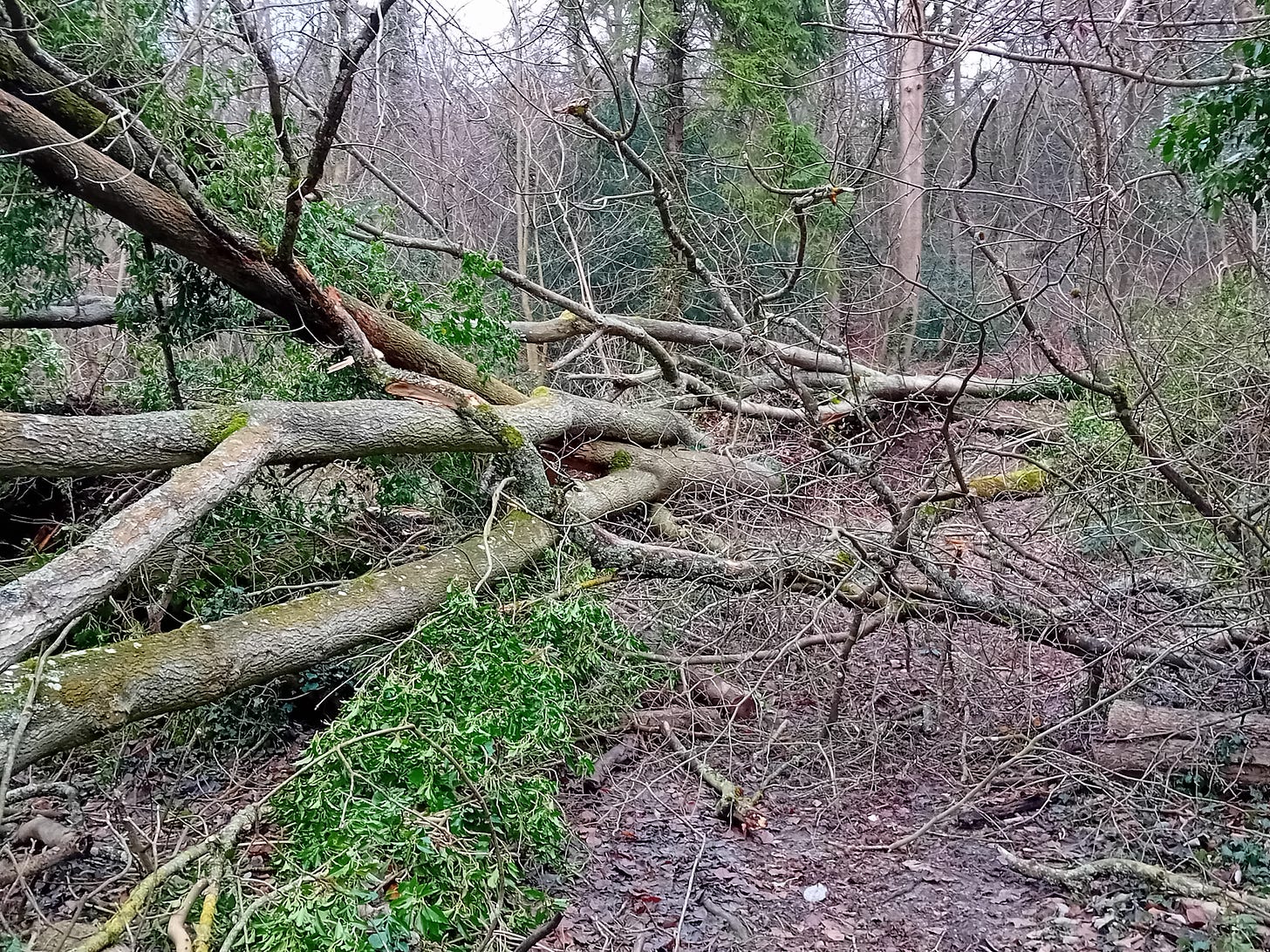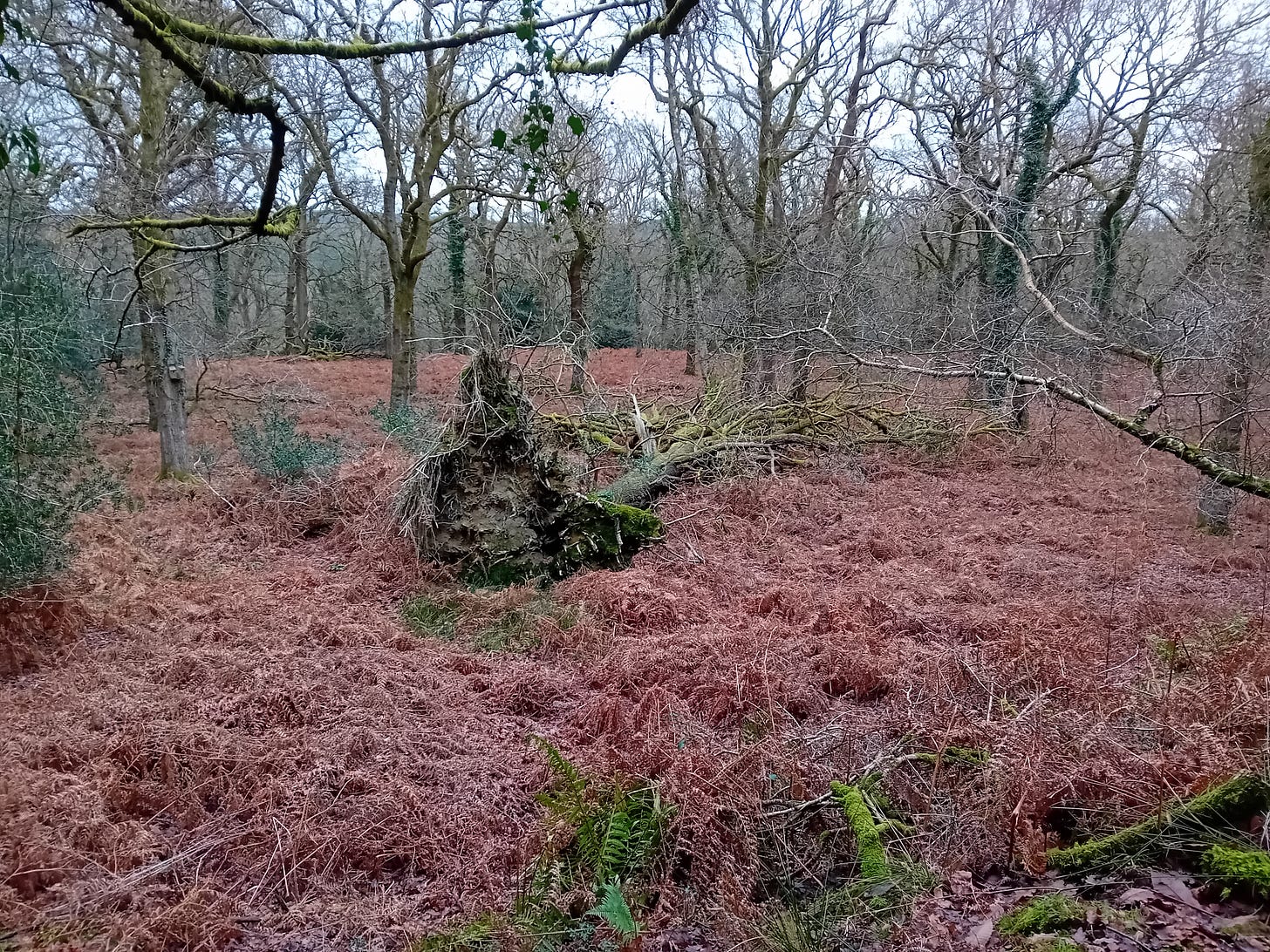Down but not out
On the lessons from the great storm of 1987, and the benefits of fallen trees
I spent much of the Christmas break away from London, visiting family in North Wales and South-West England and spending a few days in the Forest of Dean over New Year. Wherever we went there were a lot of fallen trees, many of which must have been brought down by the ferocious winds of Storms Bert and Darragh only a few weeks before. Twice we found the footpath we were walking on completely blocked by a toppled tree, and in one case the only way round was an adventurous scramble up a steep bank. Such trees will need to be cleared but many others will hopefully be left to lie in peace.
Rotting wood is an important habitat so unless they are unsafe or blocking access fallen trees are generally left to decompose in the place they grew but that wasn’t always the case. The approach has changed significantly in recent decades partly because of what happened in the aftermath of the storm on 15-16 October 1987. I was still living in Liverpool on the night when several hours of winds over 80 mph devastated vast areas of woodland in Southern England. It would be a few years before I moved to London and several more before I started taking an interest in the capital’s green spaces, so I remember the great storm only as an item on the news.
The landscapes of North Wales and North-West England that I knew and loved were barely affected and hearing about events such as the loss of all but one of the seven oaks in the town of that name meant very little to me at the time. But I’ve since read many accounts of what happened and spoken to people who were living in London and the South-East then and I now have a much better appreciation of just what an impact the storm had on this part of the country. Fifteen million trees were felled including historic specimens, vast swathes of woodland and many street trees. There were also 18 people killed and many more injured, lengthy power cuts, extensive transport disruptions and numerous broken windows, smashed roofs and collapsed buildings.
In an era before such storms were given names in Europe, this one was simply known as the great storm, and it was followed by the great clear-up – a huge rush to tidy away all that mess and hide the devastation. While much of the media reported the storm as an unmitigated disaster which needed to be put right at speed, some ecologists argued that the impact of the storm was just part of the natural lifecycle of trees and woodlands. Unfortunately, their views were largely ignored.
In the following months, numerous fallen trees, and those damaged but not yet completely toppled, were dragged from the fields and woods which had sustained them for decades or even centuries, chopped up and taken away. With them went all the benefits that they would have given back to those habitats if left undisturbed, the fungi and insect life they would have sustained for many years to come and the nutrients they would have returned to the soil. The removal itself often caused further damage too, with the use of heavy machinery crushing undergrowth and compacting the soil.
In his book Woodlands, Oliver Rackham summarises research on the impacts of the great storm which found that the effects on different types of trees varied in sometimes unexpected ways. Supposedly “healthy” specimens were no more likely to survive than “unsound” ones with hollow trunks and rotten limbs. Most of the damaged trees were young and apparently sound. Freestanding ancient trees which might be thought most susceptible to damage because of their age and lack of protection were generally the least effected. Planted trees were more likely to be uprooted than wild ones and the greatest damage was often to those in the middle of woods and plantations where overcrowding increased the risk of them being uprooted.
Many of these differences were likely to be due to what was going on below the ground rather than the physical state of the visible part of the tree. In general, isolated, free-standing trees which had developed more extensive root systems were better able to withstand the force of the wind than those whose roots were restricted by the proximity of their neighbours. It seems that trees, like humans, can develop better resilience if they are given the space to grow and develop in a way that best meets their own needs.
New trees were planted after the great storm, but these could never truly replace the ones that had been lost and removed. How could we quickly replicate something that had been growing for hundreds of years? It would have been far better to leave the fallen trees where they lay and let nature take its course, but that practice wasn’t widely accepted at the time. In fact, where uprooted trees were left alone most survived, and just started growing in a different direction, sending up shoots from the base or along the trunk. Many of these then went on to survive the great droughts of 1989 and 1990, and some even did better than many trees that had stayed upright.
Surveys of 103 woods across Britain over a 30-year period from 1971 found that by 2001 the number of species had increased in woods supposedly damaged by the great storm of 1987 and other major storms in 1990 whilst in other woods, the number of species had declined. This is because the changes resulting from the storm benefitted woodland flora that need more light to grow, such as bluebells and primroses, and certain types of birds, like warblers were able to take advantage of the increase in low ground cover created by brambles and the regrowth from fallen trees .

Given what we now know about the impact that humans have had on the climate and the fact that extreme weather events are occurring with ever greater frequency as has been only too evident in recent months, it seems likely the great storm was not a completely natural event. However, it is still true that trees fall naturally sometimes. Many live for a long time, but eventually old age gets the better of them, they fall to the ground or are blown over, creating space for new life to replace them, and for the cycle to begin again. The continued growth of woodland depends on the occasional creation of these light-giving gaps, and we spend a lot of our time as conservation volunteers removing species, particularly non-native ones such as cherry laurel, which if left unmanaged would fill those gaps too quickly, leaving slower growing plants with little opportunity to flourish.
To finish….
…a few things I’d like to share:
The value of reporting wildlife sightings: If you’ve ever been any doubt as about taking a photo of an unusual species you spot and uploading it to i-naturalist or other similar apps, then this article about a London woman who rediscovered an invasive bug should convince you it’s definitely worth doing.
How best to support birds in winter: This podcast includes an interesting discussion between the wildlife gardening expert, Kate Bradbury, and the conservationist, Nick Acheson, about the pros and cons of putting out special food for gardens birds. While there are undoubtedly many benefits, particularly during cold snaps like the current one in the UK, there are also downsides and the practice is likely to be benefitting some species at the expense of other, often more threatened, species who don’t use bird feeders.
Tell City Hall what you think about the capital’s green spaces and waterways: The Mayor of London’s environment team is currently gathering evidence to help develop new policies and is running a survey (closing 16 February 2025) asking people about the natural places they visit in London, how those places should be protected and what support they might need to be able to visit more often. If you’re a nature-loving Londoner, this is a great opportunity to highlight the places that are important to you.




Really interesting!